-
Use Cases
-
Resources
-
Pricing
Prelude to Revolution
Stamp Act passed
Mar 22, 1765
% complete
The Stamp Act was passed by the British Parliament on March 22, 1765. It imposed a direct tax on the American colonies and required them to pay a tax on every piece of printed paper they used, including legal documents, newspapers, pamphlets, and even playing cards. This act sparked widespread protest among the colonists and played a major role in uniting them against British rule. The slogan 'No taxation without representation' became a rallying cry for the American Revolution.
Sons of Liberty formed
Aug 14, 1765
% complete
The Sons of Liberty was a secret organization formed in August 14, 1765, in response to the newly imposed Stamp Act by the British government. The members of the Sons of Liberty were American colonists who strongly opposed British taxation without representation. They organized protests, boycotts, and acts of civil disobedience against the British authorities. The Sons of Liberty played a significant role in the American Revolution and ultimately contributed to the creation of an independent United States of America.
Image source: Sons of Liberty

Boston Massacre
Mar 5, 1770
% complete
The Boston Massacre was a confrontation between colonists and British soldiers on March 5, 1770. A crowd of colonists gathered around a British soldier and began to harass him. More soldiers arrived to assist their comrade and tensions escalated. The colonists threw snowballs, rocks, and sticks at the soldiers, who responded by firing into the crowd, killing five colonists. This event became a rallying cry for the colonists and fueled anti-British sentiment.
Image source: Boston Massacre
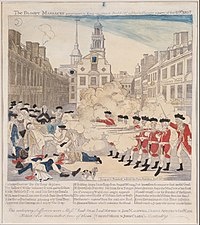
Boston Tea Party
Dec 16, 1773
% complete
The Boston Tea Party was a political protest that occurred on December 16, 1773, in Boston, Massachusetts. American colonists, frustrated and angry at Britain for imposing 'taxation without representation,' dumped 342 chests of tea into the harbor as a defiant act against British rule. This event became a significant catalyst in the lead-up to the American Revolution.
Image source: Boston Tea Party
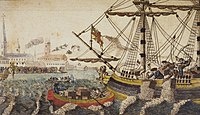
Political Developments
First Continental Congress meets
Sep 5, 1774 - Oct 26, 1774
% complete
The First Continental Congress was a meeting of delegates from twelve of the thirteen British colonies that would become the United States. It convened in Philadelphia from September 5 to October 26, 1774, to coordinate a response to the Intolerable Acts. The delegates drafted a declaration of rights and grievances, asserting the rights of the colonists to life, liberty, and property, and declaring that these rights had been violated by the British government.
Image source: First Continental Congress
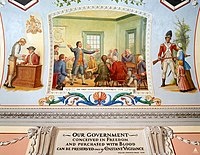
Second Continental Congress convenes
May 10, 1775
% complete
The Second Continental Congress convenes on May 10, 1775, in Philadelphia, Pennsylvania. It is a meeting of delegates from the thirteen American colonies who come together to discuss and coordinate actions against British rule. The congress serves as the de facto government of the colonies during the early stages of the American Revolution. During this meeting, the congress establishes the Continental Army, appoints George Washington as the commander-in-chief, issues the Olive Branch Petition in an attempt to achieve reconciliation with Britain, and adopts the Declaration of the Causes and Necessity of Taking Up Arms to justify armed resistance against British oppression.
Image source: Continental Congress
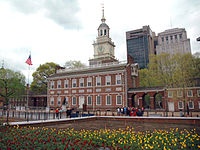
Thomas Paine publishes "Common Sense"
Jan 10, 1776
% complete
Thomas Paine publishes "Common Sense", a highly influential pamphlet that argued for American independence from Britain. The pamphlet was widely read and helped to inspire and rally support for the American Revolution.
Declaration of Independence adopted
Jul 4, 1776
% complete
On July 4, 1776, the Continental Congress adopted the Declaration of Independence, which declared the thirteen American colonies as independent states and no longer part of the British Empire.
Image source: Declaration of Independence of Ukraine

Articles of Confederation adopted
Nov 15, 1777
% complete
The Articles of Confederation were adopted by the Continental Congress on November 15, 1777. This document served as the first constitution of the United States, establishing a loose alliance of states and outlining the powers and limitations of the federal government. It provided for a weak central government with limited authority, reserving most powers to the individual states. The Articles of Confederation also established a unicameral legislature known as the Continental Congress, which had the power to declare war, make treaties, and manage relationships with foreign nations. However, it lacked the power to enforce its laws or collect taxes, leading to several challenges and ultimately the need for a stronger central government.
Image source: Articles of Confederation
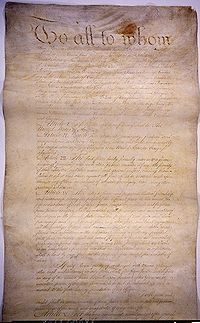
Constitution of the United States drafted
Sep 17, 1787
% complete
The Constitution of the United States was drafted by the Constitutional Convention in Philadelphia from May 25 to September 17, 1787. It is the fundamental law of the United States that establishes the structure and powers of the federal government, as well as the rights and liberties of individual citizens.
Image source: Constitution of the United States
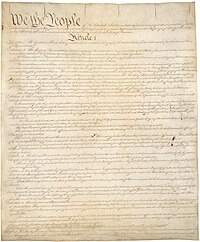
Bill of Rights ratified
Dec 15, 1791
% complete
The Bill of Rights, consisting of the first ten amendments to the United States Constitution, was ratified on December 15, 1791. These amendments guarantee important individual rights, such as the freedom of speech, religion, and the right to a fair trial.
Image source: United States Bill of Rights
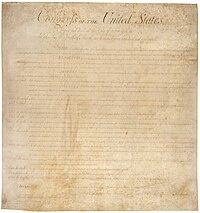
Revolutionary War Battles
Battles of Lexington and Concord
Apr 19, 1775
% complete
The Battles of Lexington and Concord were the first military engagements of the American Revolutionary War. The battles were fought on April 19, 1775 in Massachusetts between the American colonists and British soldiers. The events began when British troops were sent to seize colonial militia weapons. The first shots were fired at Lexington, and the American militia was quickly overwhelmed. The British then moved on to Concord, where they searched for hidden weapons but found very little. As the British retreated to Boston, the colonists continuously ambushed them along the way, causing heavy casualties. This marked the beginning of the war for independence for the American colonies.
Image source: Battles of Lexington and Concord

Battle of Bunker Hill
Jun 17, 1775
% complete
The Battle of Bunker Hill took place on June 17, 1775, during the early stages of the American Revolution. It was one of the first major battles of the war and marked a significant point in the conflict. The battle was fought between the American Continental Army, led by Colonel William Prescott, and British forces commanded by Major General William Howe. The American forces fortified Breed's Hill, which was mistakenly identified as Bunker Hill, leading to the battle being named as such. The British launched multiple attacks on the American position, resulting in heavy casualties on both sides. While the British eventually captured the hill, the Americans put up a strong resistance and inflicted significant losses on the enemy. The battle demonstrated the determination and fighting spirit of the American soldiers and boosted their morale. Despite the American loss, the battle was considered a strategic and moral victory as it proved that the colonists could stand up to the powerful British army. The Battle of Bunker Hill inspired future American revolutionaries and instilled a belief in their ability to fight for independence.
Image source: Battle of Bunker Hill
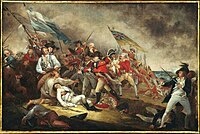
Battle of Trenton
Dec 26, 1776
% complete
The Battle of Trenton took place on December 26, 1776, during the American Revolutionary War. It was a pivotal battle in which George Washington and his Continental Army crossed the Delaware River in a surprise attack on Hessian forces. The American victory at Trenton provided a much-needed boost to morale and demonstrated the determination and resilience of the Continental Army.
Image source: Battle of Trenton
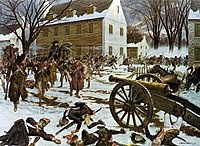
Battle of Saratoga
Sep 19, 1777 - Oct 17, 1777
% complete
The Battle of Saratoga was a turning point in the American Revolution. It took place from September 19 to October 17, 1777, in Saratoga, New York. The battle was fought between the British forces, led by General John Burgoyne, and the American forces, led by General Horatio Gates. The Americans were able to defeat the British, resulting in the surrender of General Burgoyne and his troops. This victory boosted morale for the American cause and convinced France to officially ally with the Americans in their fight for independence.
Image source: Battles of Saratoga
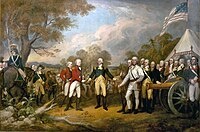
Valley Forge winter encampment
Dec 19, 1777 - Jun 19, 1778
% complete
Valley Forge winter encampment was a critical event during the American Revolution. It took place from December 19, 1777, to June 19, 1778, in Valley Forge, Pennsylvania. The Continental Army, led by General George Washington, established their winter quarters at Valley Forge after suffering a series of defeats and retreating from British forces. The conditions at Valley Forge were harsh, with soldiers facing extreme cold, hunger, and disease. However, the winter encampment also proved to be a turning point for the Continental Army. Under the leadership of General Washington, the soldiers at Valley Forge underwent intense training, discipline, and reorganization. They emerged in the spring of 1778 as a more unified and disciplined fighting force, better prepared to face the British. The Valley Forge winter encampment symbolizes the resilience and determination of the Continental Army and their commitment to the cause of American independence.
Image source: Valley Forge

Battle of Yorktown
Sep 28, 1781 - Oct 19, 1781
% complete
The Battle of Yorktown was the last major land battle of the American Revolution. It took place from September 28 to October 19, 1781, in Yorktown, Virginia. The American forces, led by General George Washington, along with French forces commanded by General Comte de Rochambeau, besieged the British army under General Charles Cornwallis. The American and French troops successfully surrounded and bombarded Yorktown, forcing Cornwallis to surrender. This victory ultimately led to the end of the war and the recognition of American independence.
Image source: Siege of Yorktown

Diplomatic Efforts
Olive Branch Petition sent to King George III
Jul 8, 1775
% complete
The Olive Branch Petition was a final attempt by the colonists to avoid going to war with Great Britain. It was sent to King George III on July 8, 1775, as a plea for peace and reconciliation. The petition expressed the colonists' loyalty to the king and their desire for a peaceful resolution to the conflict. However, the king rejected the petition and instead declared the colonies to be in a state of rebellion.
Image source: Olive Branch Petition
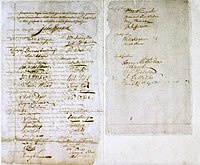
France formally allies with the American Revolution
Feb 6, 1778
% complete
France formally allies with the American Revolution on February 6, 1778. This alliance is a turning point in the war as France provides financial, military, and naval support to the American colonies. The Treaty of Alliance, signed in Paris, establishes a formal alliance between France and the United States, promising mutual assistance in the event of war with Great Britain. French aid plays a crucial role in American victories, such as the Battle of Yorktown, and ultimately helps secure American independence.
Treaty of Paris signed
Sep 3, 1783
% complete
The Treaty of Paris was signed on September 3, 1783, officially ending the American Revolutionary War between Great Britain and the United States of America. The treaty recognized the independence of the United States and established its boundaries. It also granted fishing rights to American fishermen in the North Atlantic and resolved issues related to loyalist property rights. The signing of the Treaty of Paris marked the formal conclusion of the war and the beginning of a new era for the United States as a sovereign nation.
Image source: Treaty of Paris (1783)
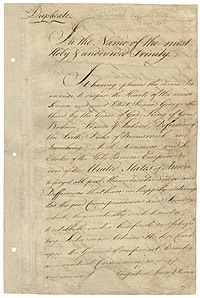
Jay Treaty signed
Nov 19, 1794
% complete
The Jay Treaty was signed on November 19, 1794, between the United States and Great Britain. It was negotiated by Chief Justice John Jay and aimed to settle various issues between the two countries, including trade disputes, British military presence on the American frontier, and the seizure of American ships. The treaty also sought to improve diplomatic relations and prevent another war between the United States and Great Britain. While controversial at the time, the Jay Treaty ultimately helped ease tensions and preserve peace between the two nations.
Image source: Jay Treaty
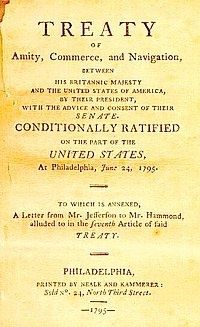
Aftermath and Impact
George Washington elected as the first President
Apr 30, 1789
% complete
George Washington was elected as the first President of the United States on April 30, 1789. He took the oath of office in New York City and served two terms, from 1789 to 1797. Washington's election marked the beginning of the presidency as outlined in the newly ratified United States Constitution.
Image source: George Washington
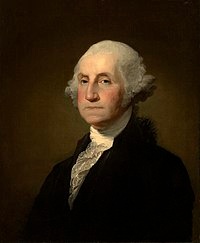
Alexander Hamilton becomes Secretary of the Treasury
Sep 11, 1789
% complete
Alexander Hamilton becomes Secretary of the Treasury on September 11, 1789. As Secretary of the Treasury, Hamilton played a key role in shaping the economic policies of the United States. He advocated for a strong central government and a national bank, and his financial plans helped stabilize the economy and establish the credit of the new nation. Hamilton's tenure as Secretary of the Treasury was marked by his clashes with political opponents, including Thomas Jefferson and James Madison, over issues such as the national debt and the establishment of a national bank. Despite these conflicts, Hamilton's leadership in economic matters laid the foundation for the financial success of the United States.
Whiskey Rebellion
Jul 1794
% complete
The Whiskey Rebellion was a violent tax protest in the United States beginning in 1791 and ending in 1794 during the presidency of George Washington. The rebellion was primarily caused by the imposition of a federal excise tax on distilled spirits, which angered farmers and rural dwellers who produced whiskey. In July 1794, the rebellion reached its peak when a group of rebels attacked and destroyed the home of a tax collector in Pennsylvania. President Washington responded by mobilizing a military force of approximately 13,000 soldiers to suppress the rebellion. The rebellion was ultimately crushed, and its leaders were arrested and tried for treason.
Image source: Whiskey Rebellion
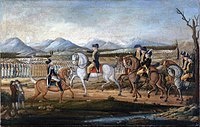
Washington's Farewell Address
Sep 19, 1796
% complete
Washington's Farewell Address was a letter written by George Washington to the American people in 1796, as his second term as president was coming to an end. In the address, Washington warned against political factions and foreign alliances, emphasized the importance of maintaining national unity and the Constitution, and announced his decision to retire from public life. The Farewell Address has become one of the most famous speeches in American history and is often cited as a foundational document of American political tradition.
Image source: George Washington's Farewell Address
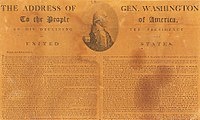
Alien and Sedition Acts passed
Jul 14, 1798
% complete
The Alien and Sedition Acts were a series of four laws passed by the United States Congress in 1798. These acts were signed into law by President John Adams and were aimed at protecting the United States from foreign influences and internal dissent. The Alien Acts increased the requirements for immigrants to become citizens, allowing the government to deport or imprison any non-citizen deemed 'dangerous' to the country. The Sedition Act made it a crime to criticize the government, with strict penalties for those convicted. These acts were highly controversial and were seen by many as a violation of the First Amendment rights of free speech and press.
Kentucky and Virginia Resolutions
Nov 1798
% complete
The Kentucky and Virginia Resolutions were political statements that denounced the Alien and Sedition Acts enacted by the federal government. The resolutions were drafted by Vice President Thomas Jefferson and James Madison, respectively. They argued that states had the right to interpret the Constitution and nullify federal laws that they deemed unconstitutional. The Kentucky Resolution was adopted by the Kentucky General Assembly on November 10, 1798, and the Virginia Resolution was adopted by the Virginia General Assembly on November 21, 1798.
Image source: Kentucky and Virginia Resolutions
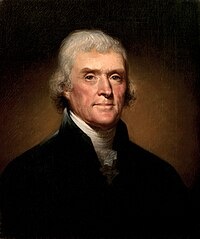
Thomas Jefferson elected as President
Mar 4, 1801
% complete
Thomas Jefferson was elected as the third President of the United States on March 4, 1801. He was the first candidate representing the Democratic-Republican Party to win the presidency. Jefferson served two terms as President, from 1801 to 1809.
Image source: Thomas Jefferson
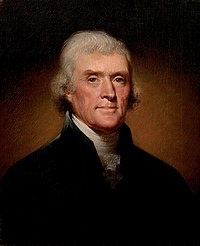
Marbury v. Madison establishes judicial review
Feb 24, 1803
% complete
Marbury v. Madison establishes judicial review on February 24, 1803. In this landmark case, the Supreme Court of the United States established its power of judicial review, which allows the court to review the constitutionality of laws passed by Congress.
Louisiana Purchase
Apr 30, 1803
% complete
The Louisiana Purchase was a land deal between the United States and France, in which the U.S. acquired approximately 827,000 square miles of land west of the Mississippi River for $15 million. The purchase doubled the size of the United States and opened up vast territories for exploration and settlement.
Image source: Louisiana Purchase
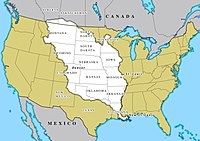
Key Facts
- The Boston Tea Party took place in 1773 as a protest against the Tea Act imposed by the British.
- The Declaration of Independence was adopted by the Continental Congress on July 4, 1776.
- The Battle of Saratoga in 1777 was a turning point in the war, as it convinced France to support the American cause.
- The Treaty of Paris was signed in 1783, officially ending the war and recognizing the United States as a sovereign nation.
- The American Revolution inspired other movements for independence around the world, including the French Revolution.
Source
This American Revolution timeline was generated with the help of AI using information found on the internet.
We strive to make these timelines as accurate as possible, but occasionally inaccurates slip in. If you notice anything amiss, let us know at [email protected] and we'll correct it for future visitors.
Create a timeline like this one for free
Preceden lets you create stunning timelines using AI or manually.
Customize your timeline with one of our low-cost paid plans
Export your timeline, add your own events, edit or remove AI-generated events, and much more
Free
$
0
free forever
No credit card required.
Basic
$
10
/month
billed annually
Cancel anytime.
Pro
$
16
/month
billed annually
Cancel anytime.
Common Questions
Can I cancel anytime?
Yes. You can cancel your subscription from your account page at anytime which will ensure you are not charged again. If you cancel you can still access your subscription for the full time period you paid for.
Will you send an annual renewal reminder?
Yes, we will email you a reminder prior to the annual renewal and will also email you a receipt.
Do you offer refunds?
Yes. You can email us within 15 days of any payment and we will issue you a full refund.
What if I have more questions?
Check out our pricing docs or send us an email anytime: [email protected].